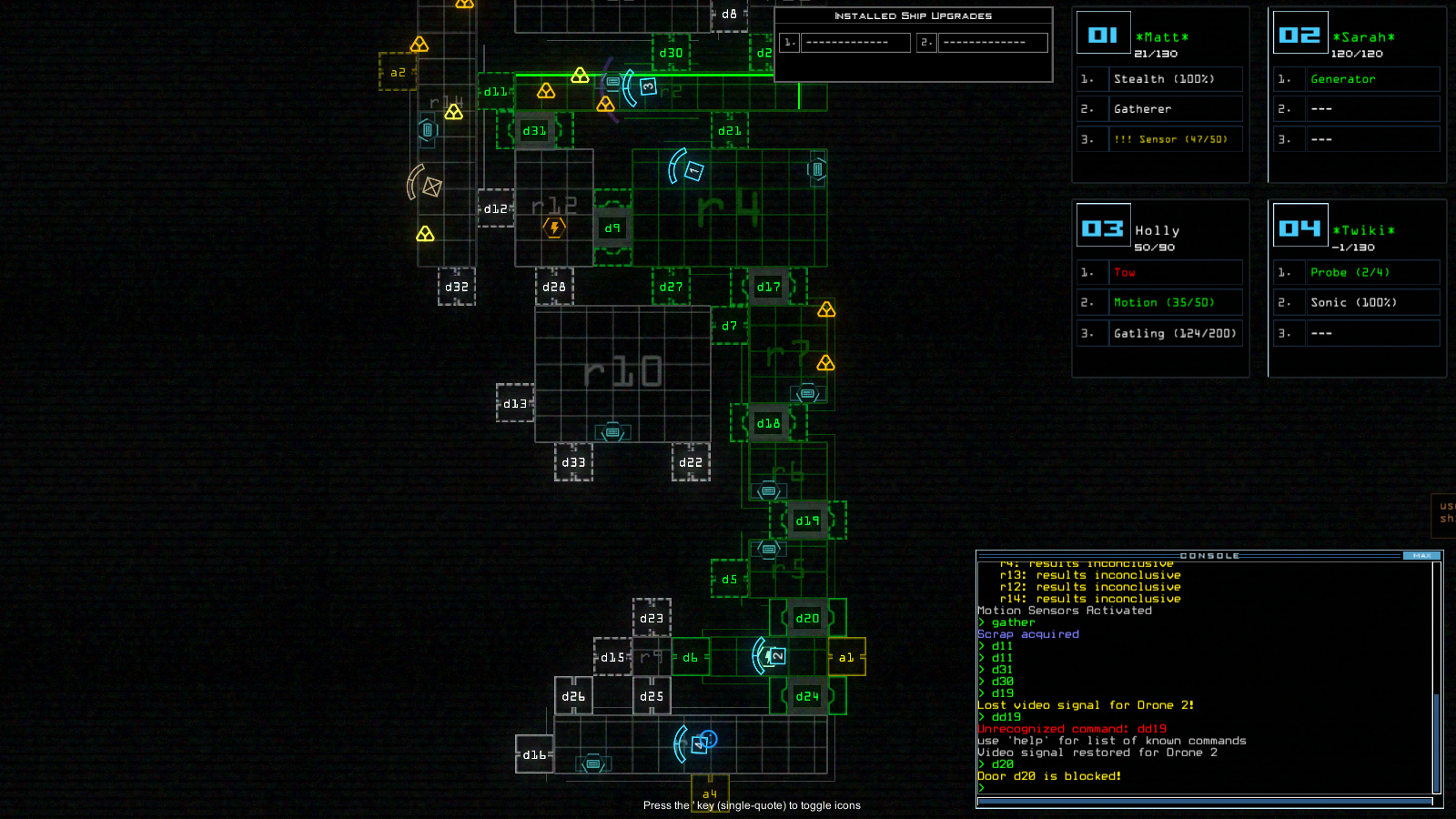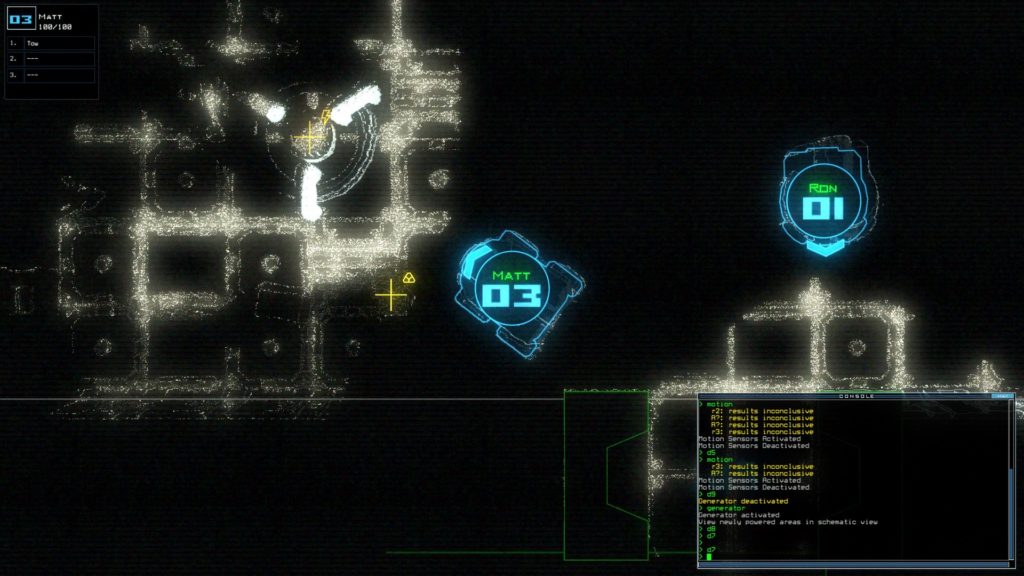Surrounded by the hum of servers and monitors I anxiously await a report from “Ethan”, my scout Drone three rooms over. Chirping happily to himself as he drops a probe and observes it skitter off into the dark, eagerly expectant for the little bug to give good intel on the room. My monitor lights up with all green, and I smile at the thought of actually commandeering this ship. Lots of good fuel and scrap here to make into my new home. Door d12 slides closed as I speak to the ship through my command interface; I jacked in the moment we docked, giving myself an edge against whatever may lurk in the dark. D13 opens up ahead and the little probe skitters through. All of a sudden flashing lights on my panel indicate that my probe is taking damage from an unknown aggressor! The probe flees back through the open door as I give the command to lock that bulkhead. The door jams on something big and refuses to close. Running out of options and time I give the command: “Navigate home” and desperately hope to recover my drones before they get consumed. “Ethan” jets forward towards the escape route I plot for him, but not quick enough and goes down. I send “Wally” to power a nearby generator to control the exterior doors, and decide to vent atmosphere in the contaminated rooms through an adjoining airlock. I’ll lose Ethan, but I’ll be able to recover the others. Klaxons blaring about internal rooms being exposed to vacuum and radiation drown out any other noise from the drones. The instant I open the door all traces of life (and my leading drone Ethan) are instantly sucked into the inky black of space. The force of the exterior airlock popping so rapidly damages the door I had been using to access that compartment to the point of failure. I seal the airlock and send a motion pulse through the ship. All clear for the moment. Moving forward with “Simon” my reserve drone, I discover a new friend in a forward compartment in the new path I’m forced to take. His name is “Echo”. I toss a towline and drag him back aboard my ship and recall everyone. Not a complete loss for a scrubbed mission.
Duskers has a lot of interesting things going for it, but first and foremost, is it’s really interesting interface design. The input controls are entirely command line, which very effectively immerses you within the drone operator’s world. You are entirely in command of the mission at all times, and when things go wrong, there’s no one to blame but yourself. The game gives you exactly one warning about opening external airlock doors and the implications of doing so, and then allows you to make your own mistakes as you see fit. Since the game doesn’t rely on conventional controls like drag and drop or click to target mechanics, every move you make must be carefully considered first. It’s surprising how scary it can be watching your drones get chased around a space ship by unknown horrors that are only a few bulkhead doors away. If you forget to type the command to close your home airlock hatch, something unfriendly might find its way to you.
Scrap and fuel are the main commodity in this game. Needed to upgrade and repair your drones, scrap is typically readily available throughout the ship, giving you more or less enough to break even on each mission. Fuel is scarce, but there’s usually at least enough on each ship to allow you to explore the next vessel in the blackness. You can find ship and drone upgrades scattered throughout the wreckage, and occasionally a damaged drone that can be revitalized and added to your fleet. In order to recover these bigger items and new friends, they need to be towed by an aptly equipped drone back to your home room.
There are interesting ways to dispatch foes, but it’s worth noting that it’s not always best to simply vent everything out into space. There’s a tendency to want to flush the ship of bad guys and then explore at your leisure. However, opening an airlock without a ship attached to it isn’t apparently very good for wall integrity. Explosive decompressions, while effective, damage goods and materials in rooms to non-recoverable states (meaning no loot from that room), and more often than not will damage internal and external bulkhead doors to the point of non-function. This does empty the room, but if you can’t get to it afterwards, was it worth it? Instead the game allows you to herd enemies through careful door manipulation. The monsters and creatures seem drawn to new sounds like a door panel swinging open (or a hapless drone that wanders in). In this way, you can encourage the creatures to leave their current room and go into the next by simply leaving a door open for them. What makes this strategy dangerous to use continuously is that your bots (if they are lucky enough to have a motion sensor upgrade) can only use so many sensor sweeps of adjoining rooms before it breaks and you need to find a new one. Early gameplay was filled with pinging every room before it was deemed safe to open and explore while the counter rapidly decreased. After breaking the motion sensor from overuse, exploration shifted to opening a door, navigating a drone in and having a pre-typed the command to lock the door waiting for confirmation for a hasty retreat.
Occasionally a ship will have a timed event or unexpected scenario based on rooms explored or actions performed prior. “Warning: Asteroid collision imminent! Damage to rooms R7 (58%) and R9 (96%) will occur in 2 minutes” Flashes across the screen. Since you’ve no idea what other rooms will be hit, it’s a good idea to speed up your exploration process and get the hell off the ship. If you decide to wait it out from the safety of your ship and then explore post-impact, many rooms may now be inaccessible or the ship may be entirely destroyed. Radiation can flood compartments and break equipment or power sources, Vacuum can exert too much pressure on internal bulkhead doors and cause them to vent atmosphere unexpectedly. Best to abandon ship once an external airlock blows or an asteroid rips a piece out of the hull.
Since the game revolves around space ship exploration, it’s quite easy to move your ship to a different airlock. Typing the words “Dock A3” will move your spaceship from airlock 1 to airlock 3. This is a good tactic when ships get larger and the path to navigate back to the safety of your ship becomes more difficult. Moving the base to where your drones are, can have its advantages. Simply docking on each airlock and opening the door to your base is not necessarily the best plan, you might unknowingly open your airlock into a breached room and get sucked out of your ship and killed, or perhaps let in an uninvited guest that waits in that room.
The game has a heavy Alien feel to it, and I mean that in the best way possible. The Alien franchise, the 2015 game and movies included have always felt like the technology they used was both advanced and ancient at the same time. They needed it to survive the hell they were in, but it continually broke down, needed repairs and felt very real as a result. It was easy for the audience to empathize with the heroine who smacked the side of the motion sensor and silently screamed for it to work; in some capacity or another we’ve all experienced this feeling with technology (though perhaps not to the same life threatening level). Duskers in the same way provides the feeling that you are working within a familiar world. Command line interface and tactile keyboard setup, interfacing with impossibly advanced drones but they require constant upkeep and micro-management to work. It adds a level of reality that works for this game. When a drone breaks down, I silently curse myself for not scanning that room first, or forgetting to disable the turret system that I turned on before. When I use up my scanner utility on drone “Wally” I get annoyed and scared that I forgot to repair it and in doing so just made my life that much more difficult.
There is a dark storyline that becomes more and more clear the farther you get in the game. Each space station has a chance of discovering a log file from the last occupants about what has been happening in each system. As you encounter more ships, you learn more about the universe you inhabit. The game is a rouge-like, in that when you die, you lose progress and upgrades. However you do keep all the log files you’ve ever discovered, meaning that you can beat the game through multiple play-throughs.
Controls in the game cannot be described as “tight” or “responsive” because there really aren’t any. It’s actually the exact opposite: Clunky and inefficient and slow. It forces you to make deliberate choices and live with the consequences of your actions. Besides when you are directly controlling your drone through rooms while scanning for any scrap or upgrades, everything from navigation to door control is entirely run through a bash shell window. While this is certainly a step away from the norm, it’s part of what defines Duskers as so innovative. Certainly it adds to the level of fear and stress while playing, as your enemies are nowhere near as slow when it comes to running through open doors to shred digital faces.
The graphics of the game are simple and light. The only discerning difference between each drone is the color palette that differentiates each unit’s line of sight while directly controlled. Otherwise, the game revolves entirely between the grid layout room view, or the camera feed from the drone itself as you pilot it through the world. Everything is top-down and severely limited in terms of sight line range. Because the graphics and controls are simple, the game is in fact very small, and requires little to no horsepower to run.
The audio is simplistic. No music, just the hum of engines and computer systems around you clicking away while you explore. Not every game needs an up beat exploration jam, which in this case would simply detract from the experience. Instead, the audio only changes when you are focused on and directly controlling a drone, in which you hear it’s immediate surroundings and the scratching on walls in adjoining rooms. Terrifying.
There is heavy replay value to this game as well, in that each ship is randomly generated, and the level progression makes you want to continue exploring until your last drone bites the dust. Duskers currently retails on Steam for $20 USD, which feels appropriate after playing the game. It fully delivers on experience. Beyond the main story mode, there are weekly and monthly challenge missions that include different objectives and difficulty levels for the community. This helps to keep things fresh, and also provide a different type of challenge if the main game becomes stale.
Theres not much the game could have done better. For what it is, the game excels at providing a space exploration horror sim, hours of entertainment and a unique gaming experience unlike anything else on the market. Even if you have never operated anything in command line, this game does not expect or require you to have any experience in this regard. If you can type on a keyboard, you’ll pick up the controls in 2 minutes. Now if you’ll excuse me I have to send “Wally” “Echo” and “Simon” into Sevastopol Station.
Check out the trailer here:
[youtube link=”http://www.youtube.com/watch?v=dux33m_7M6w” width=”690″ height=”415″]
For more information, visit the developer webpage
And the Steam link page

